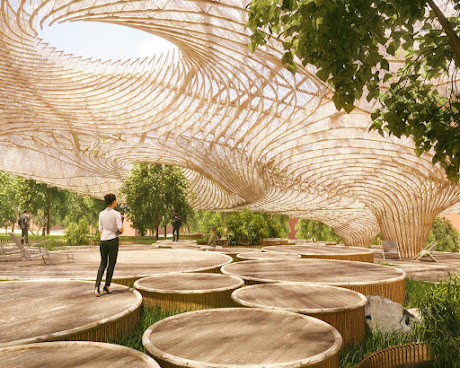Parametric Design's Influence on Today's Architecture
Parametric Design’s Influence on Today’s Architecture
Parametric designing or the use if artificial intelligence
in designing is increasing over the years. It is a form of generative designing
based on a given set of algorithms, codes and scripts which are fed into a
software to create responsive forms. Most used software for this form of
designing are Robert McNeel & Associates’ Grasshopper, Bentley Systems’
Generative Components, and Revit Autodesk’s Dynamo.
Parametric design considers the given variables,
codes, data and how they interact with each other and their collective response
to these variations. It helps the student and designers in understanding the impact
each variable can have on a design. Multiple parameters are used to define the
bounds of a generated design which encourages the designers to think about
multiple ways to resolve issues that may arise during said designing. The
amount of creative engagement with design is also increased because each step
in the code can have a large impact on the final design.
It helps in visualization of the final product and can
also aid in the fabrication or manufacturing process of the project. Since it
makes use of artificial intelligence, the designs produced are usually highly complex
and more often than not, too complicated for the human mind to comprehend unaided.
Parametric software aid in understanding the relationship
between human beings, the built environment and the natural forces and their
subsequent interaction. It helps in producing designs that effectively
incorporate the problems and challenges with their proposed solutions within
given bounds which are capable of responding to variable site conditions.
If we take an example of urban planning, we see that
traditional ways of design thinking often fails to predict the future needs
related to growth of population, immigration, cultural or climatic shifts and
propose a plan that can effectively respond to these criteria. With parametric
design, a new method of planning can be developed which could address these
issues. Not only can it help in predicting the future population growth and
challenges that may arise, but also be able to incorporate these variables in
order to modify the design and produce a plan that evolves as needed.
Spatial needs like human interaction with the built space
and natural forces like sunlight intensity, wind flow and direction, and
seismic activities can be predicted and incorporated in the code to create
forms that provide solutions for these problems. Variations in rainfall
pattern, snow loads, climatic change and challenges like global warming can be
dealt with parametric designing as it is also capable of producing sustainable and
energy efficient interventions.
If we look at the proposed structure ‘Flow Fields’
developed in PAACADEMY’s studio workshop on ‘Eco-Parametric Structures’. The proposed
design takes into consideration, the placement of trees and their obstruction and
other existing elements like large, immovable rocks. Furthermore, the size of
the openings took into consideration the sun intensity, wind pattern and optimal
visibility to the natural surroundings.
It is modular and makes use of bamboo which is highly
flexible and is sustainable due to its high growth rate. It also helped in achieving
the organic curves which resulted in a highly accurate and a clean construction
process, since fabrication was largely done through computational designing.
To conclude, parametric designing has the potential to
create highly complex forms which can easily surpass the designs created by the
human mind. It paves the way forward for sustainable and responsive design
which have the capability to evolve with the natural and built environment, and
the needs of humans.
Citations:
Koumari, Luka. “What Is Parametric Design in Architecture?” ParametricArchitecture, 18 Feb. 2022, parametric-architecture.com/what-is-parametric-design-in-architecture/.
Hassansadeh, Hamid. “Flow Fields - Eco-Parametric Structures - PAACADEMY.” ParametricArchitecture, 28 Apr. 2021, parametric-architecture.com/flow-fields-eco-parametric-structures-paacademy/.
Sawantt, Saili. “8 Spectacular Parametric Designs Generating Sustainable Architecture – Parametric Architecture.” Parametric Architecture, 13 Sept. 2022, parametric-architecture.com/8-spectacular-parametric-designs-generating-sustainable-architecture/.
Marc
Aurel Schnable. “Parametric
Designing in Architecture - A parametric design studio - University of Sydney,
Australia”

Comments
Post a Comment